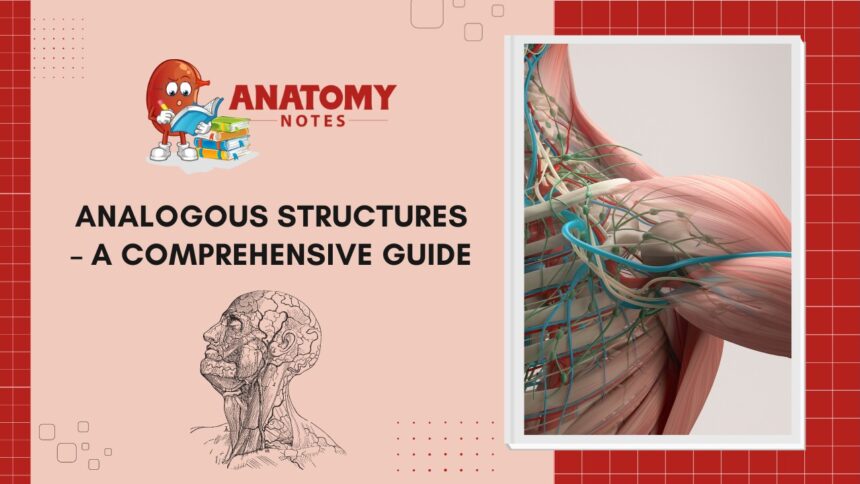Introduction to Analogous Structures
Welcome to the fascinating world of biology where nature unveils its secrets through intricate structures and patterns. Today, we delve into the realm of analogous structures, a concept that highlights the marvel of evolution and adaptation in living organisms. Buckle up as we take a deep dive into the parallel paths taken by different species in developing similar features for survival. Get ready to be amazed by the wonders of nature and how it shapes life as we know it!
Definition and Importance of Analogous Structures
Analogous structures in biology refer to organs or body parts in different species that have a similar function but do not share a common evolutionary origin. These structures are crucial for understanding the adaptability and survival strategies of various organisms in their respective environments.
The importance of analogous structures lies in how they showcase the concept of convergent evolution, where unrelated species develop similar traits to thrive in comparable ecological niches. By studying these similarities, scientists can gain insights into how natural selection shapes living organisms over time.
Moreover, analogous structures provide evidence for the role of adaptation in driving biological diversity. They highlight how diverse species can independently evolve solutions to common challenges faced in their habitats, ultimately contributing to the intricate web of life on Earth.
Understanding the significance of analogous structures is fundamental to unraveling the complexities of biological evolution and appreciating the marvels of nature’s ingenuity.
Analogous vs. Homologous Structures
When exploring the world of biology, one may come across the terms “analogous” and “homologous structures.” While both concepts involve similarities in organisms, their distinctions are crucial. Analogous structures refer to organs or body parts that serve similar functions but have different evolutionary origins. Think wings of a bat versus those of a bird – both adapted for flight, yet evolved independently.
On the other hand, homologous structures are features inherited from a common ancestor. Consider the limbs of vertebrates – whether human arms or whale flippers, they share a fundamental skeletal structure despite variations in function. Understanding these differences sheds light on the intricacies of evolutionary biology and how species adapt to diverse environments over time.
By discerning between analogous and homologous structures, scientists can decipher the complex web of life’s evolution with greater clarity.
Examples of Analogous Structures in Nature
Analogous structures in nature showcase the fascinating ways different species adapt to similar environmental challenges. Take a look at the wings of birds, bats, and insects – while they may have distinct origins, they all serve the same purpose of flight. The streamlined bodies of sharks and dolphins also reflect convergent evolution, allowing them to navigate through water with efficiency.
Another intriguing example is the camera-like eyes found in octopuses and humans; despite their evolutionary differences, both possess complex visual systems for hunting or navigating their surroundings. Even though these organisms belong to diverse branches of the tree of life, analogous structures highlight their shared need for survival strategies that work effectively in their respective habitats.
From tree-dwelling animals developing grasping hands to aid climbing to succulent plants evolving similar water-storing structures in arid environments – examples of analogous structures across various species continue to captivate scientists and nature enthusiasts alike.
The Role of Evolution in Analogous Structures
Evolution plays a crucial role in shaping analogous structures found in diverse species across the natural world. Over millions of years, organisms have adapted to their environments through the process of natural selection. This has led to the development of similar traits in unrelated species facing similar ecological challenges.
Analogous structures are not evidence of a shared common ancestor but rather a result of convergent evolution, where different species independently evolve comparable characteristics. This phenomenon highlights the remarkable ability of living organisms to adapt and thrive in various habitats.
Through evolutionary pressures such as predation, competition for resources, and environmental changes, organisms have developed analogous structures that enhance their chances of survival. These structures may serve similar functions despite arising from distinct genetic backgrounds.
Understanding how evolution influences the formation of analogous structures provides valuable insights into the complexity and diversity of life on Earth. It showcases nature’s ingenuity in creating solutions to common problems faced by different species throughout history.
Convergent Evolution and Analogous Structures
Have you ever wondered how diverse species can develop similar traits despite not sharing a recent common ancestor? It’s all thanks to convergent evolution, a fascinating process where unrelated organisms independently evolve analogous structures to adapt to similar environmental challenges.
Convergent evolution showcases nature’s incredible ability to find optimal solutions for survival in different ecosystems. From the streamlined bodies of dolphins and sharks for efficient swimming to the wings of birds, bats, and insects enabling flight, these analogous structures have evolved separately but serve similar functions.
This phenomenon highlights the power of natural selection in shaping the characteristics of organisms over time. By studying convergent evolution and analogous structures, scientists gain valuable insights into how different species can arrive at comparable adaptations through distinct evolutionary paths.
Next time you marvel at the striking similarities between species that are not closely related, remember that it’s all part of nature’s ingenious way of ensuring survival in a constantly changing world.
Adaptation and Survival: How Analogous Structures Develop
Adaptation and survival go hand in hand when it comes to the development of analogous structures in nature. Over time, organisms have evolved these structures as a response to their environment and the challenges they face.
Through natural selection, species with advantageous traits are more likely to survive and pass on their genes, including those related to analogous structures. These adaptations may not be genetically similar but serve similar functions due to environmental pressures.
Analogous structures develop independently in different species facing similar ecological conditions. This process showcases the remarkable ability of living organisms to adapt and thrive in diverse habitats.
The evolution of analogous structures highlights the incredible diversity and ingenuity found in nature’s solutions for survival. Whether it’s wings for flight or fins for swimming, these adaptations demonstrate the endless possibilities that arise from evolutionary processes over time.
Comparing Analogous Structures Across Different Species
When it comes to comparing analogous structures across different species, it’s fascinating to see how evolution has led to similar solutions in unrelated organisms. For instance, the wings of bats and birds may look alike and serve the same purpose of flight, but they have evolved independently.
Similarly, the streamlined bodies of sharks and dolphins both help them move efficiently through water despite their distinct evolutionary paths. When we look at these examples side by side, we gain a deeper appreciation for the diversity of life on Earth.
By studying these analogous structures, scientists can uncover clues about how different species have adapted to similar environmental challenges over time. It showcases nature’s creativity in finding optimal solutions for survival in various habitats.
Comparing analogous structures highlights the interconnectedness of all living organisms and underscores the remarkable ways in which evolution shapes biological diversity.
Case Studies: Analogous Structures in Mammals, Birds, and Insects
Let’s dive into some fascinating case studies of analogous structures in different species.
Mammals like the thylacine, also known as the Tasmanian tiger, exhibit striking similarities to wolves and dogs despite being marsupials. Their skull structure and dentition bear resemblance due to similar ecological roles.
Birds provide another intriguing example with their wings. While bats have wings made of skin stretched over elongated fingers, birds’ wings consist of feathers supported by modified arm bones. Both adaptations serve a common purpose: flight.
Insects showcase analogous structures too. Take beetles and cockroaches for instance; both possess protective outer wing covers called elytra that shield their delicate hindwings during flight.
The study of these diverse examples sheds light on how evolution has shaped organisms across different taxa, leading them to develop analogous structures for survival in their respective environments.
Impact of Analogous Structures on Biodiversity
Analogous structures play a crucial role in the biodiversity of our planet. These similarities in function and form across different species contribute to the rich tapestry of life on Earth. By studying analogous structures, scientists gain insights into how various organisms have adapted to their environments over time.
The presence of analogous structures highlights the incredible diversity of life and showcases the innovative ways in which nature has solved similar challenges through evolution. This variation is essential for maintaining ecosystems’ balance and resilience, ensuring that different species can thrive in their respective niches.
Understanding the impact of analogous structures on biodiversity underscores the interconnectedness of all living organisms. It emphasizes how each species, no matter how small or seemingly insignificant, contributes to the intricate web of life that sustains our planet.
Scientific Methods for Studying Analogous Structures
When it comes to studying analogous structures in biology, scientists utilize various scientific methods to unravel the mysteries of evolution and adaptation. One common approach is comparative anatomy, where researchers closely examine the physical characteristics of different species to identify similarities and differences in their structures.
By dissecting and analyzing organisms, scientists can gain valuable insights into how analogous structures have evolved over time.
Another method used is molecular genetics, which involves studying the genetic makeup of organisms to determine evolutionary relationships based on shared genes and proteins. This technique provides a deeper understanding of how analogous structures are inherited and modified through genetic processes. Additionally, fossil records play a crucial role in tracing the development of analogous structures throughout history by documenting transitional forms between different species.
Furthermore, experimental studies using modern technology such as gene editing tools like CRISPR allow scientists to manipulate genes and observe the effects on structural development. These cutting-edge techniques provide invaluable data for understanding the underlying mechanisms behind the formation of analogous structures in diverse species.
In essence, through a combination of traditional observational methods and innovative technological advancements, researchers continue to push the boundaries of knowledge in unraveling the fascinating world of analogous structures in biology.
Conclusion: Understanding the Significance of Analogous Structures in Biology
Understanding the significance of analogous structures in biology is crucial for grasping the complexities of evolution and adaptation across different species. By comparing and studying these structures, scientists can unravel the intricate ways in which organisms have adapted to their environments over time.
Analogous structures not only showcase the diversity of life on Earth but also highlight how similar environmental pressures can lead to similar evolutionary outcomes in unrelated species. Appreciating the role of analogous structures allows us to delve deeper into the interconnected web of biodiversity and gain a greater understanding of the natural world around us.
Frequently Asked Questions
Q1. Can analogous structures be used as evidence for evolution?
Yes, analogous structures can provide evidence for convergent evolution and showcase how different species adapt to similar environments independently over time.
Q2. Are homologous structures more important than analogous structures in understanding evolutionary relationships?
Both homologous and analogous structures play crucial roles in understanding evolutionary relationships. Homologous structures highlight common ancestry, while analogous structures demonstrate adaptation to similar environmental pressures.
Q3. How do scientists differentiate between homologous and analogous structures?
Scientists analyze the underlying genetic and developmental pathways of organisms to determine whether similarities are due to shared ancestry (homology) or convergent evolution (analogy).
Q4. Can analogous structures evolve into homologous ones over time?
While it’s rare, there are cases where what were once considered purely analogous structures may develop into more structurally similar forms due to shared genetic changes through convergent evolution.




